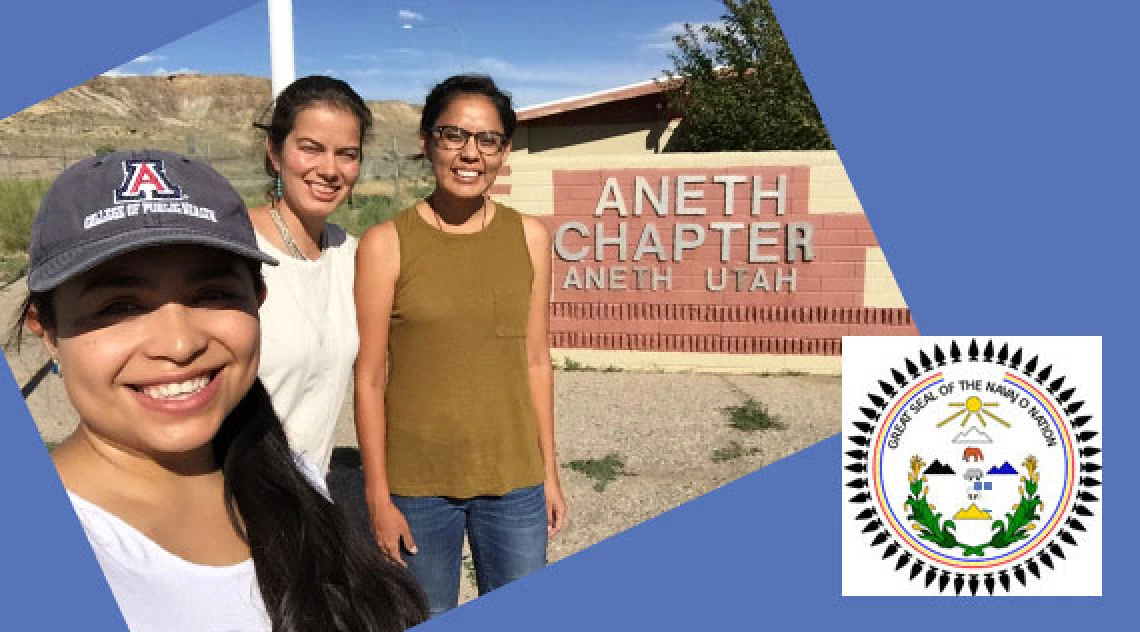UA SRP Trainee Takes Leadership Role in Training and Household Sampling with Navajo Community Health Representatives

University of Arizona Superfund Research Program (UA SRP) Trainee, Yoshira Ornelas Van Horne, led an environmental health training and household exposure sampling campaign with Navajo Department of Health Community Health Representatives (CHRs). Ornelas Van Horne is an Environmental Health Sciences doctoral student in the UA Mel and Enid Zuckerman College of Public Health. She headed the development of the environmental health training, household questionnaires, and sampling protocols for the collection of environmental and biomonitoring samples.
Ornelas Van Horne led a multi-stakeholder team the first week of August 2016 that consisted of Dr. Paloma Beamer (UA Public Health and UA SRP collaborator), Dr. Karletta Chief (UA SRP Community Engagement Core - CEC), Denise Moreno Ramírez (UA SRP CEC), Corinna Sabaque (UA Public Health), Heidi Dugi (UA Public Health), and Rachelle Begay (UA Center for Indigenous Environmental Health Research). Navajo health expert and collaborator Al Yazzie also attended the training and provided Navajo language translation support regarding how to ask questions and the use of cultural protocols. The training aimed at better preparing the CHRs to deal with the community concerns that arose as a result of the Gold King Mine spill and to increase their capacity on environmental health research. Training topics included: human subjects training, collection of urine samples, analysis of blood for lead with a finger-prick sample, environmental monitoring methods, how to administer a detailed questionnaire (diet, exposure activities, and risk perception), and environmental household sampling (drinking water, soil, and dust wipes). The household sampling is part of the recently funded NIEHS R21 grant obtained by Dr. Karletta Chief and Dr. Paloma Beamer entitled “Tó’Łítso, the water is yellow: Investigating short term exposure and risk perception of Navajo communities to the Gold King Mine Toxic Spill.”
The August 2016 field work was the first step towards developing a partnership and outreach program with Navajo Department of Health CHR Program Director Mae-Gilene Begay and Shiprock Supervisor Brenette Pine. The UA SRP CEC complemented and enhanced the training beyond the scope of the R21 by developing training materials on exposure for the CHRs, in addition to fact sheets developed shortly after the spill occurred. After an intense and packed nine-hour training day, the CHRs were presented with certificates in Environmental Health, Lead Care II blood screening, and Community Partner Research Ethics. Dr. Chief stated, “I am impressed by the dedication of the Navajo CHRs to become local experts on environmental toxicology and the Gold King Mine spill. It was an honor to work with them.”
The next four days were dedicated to the household sampling campaign in the communities of Upper Fruitland, Shiprock, and Aneth. These activities were featured in a Navajo Times article. According to Beamer, “We have been honored to collaborate with Mae-Gilene Begay, Brenette Pine and their teams to develop a project we hope will answer the concerns raised by the affected communities.” Ornelas Van Horne added, “The CHRs are truly an amazing group of individuals, we would not have been able to reach our sampling goal without them. We learned so much from them in regard to community engagement practices, participant recruitment, and field sampling management.”
For more information and the latest updates on the project please visit the Facebook page www.facebook.com/goldminespillproject or the UA SRP page.

